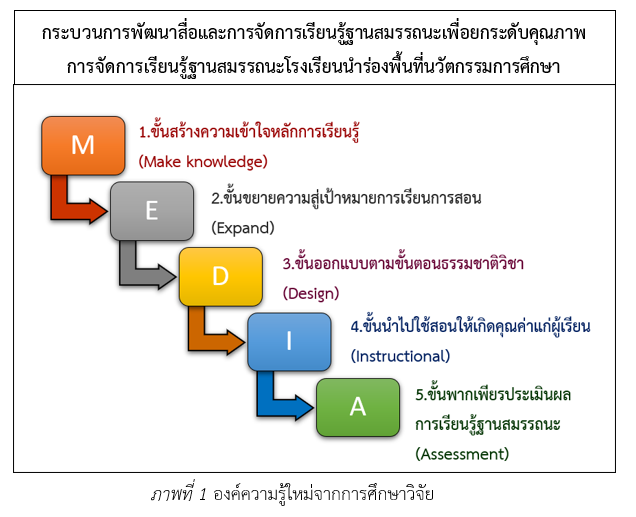การพัฒนาสื่อและการจัดการเรียนรู้ฐานสมรรถนะเพื่อยกระดับคุณภาพการจัดการเรียนรู้ฐานสมรรถนะโรงเรียนนำร่องพื้นที่นวัตกรรมการศึกษาจังหวัดกาญจนบุรี
Main Article Content
บทคัดย่อ
การวิจัยนี้มีวัตถุประสงค์เพื่อ 1) พัฒนานวัตกรรมคู่มือการพัฒนาสื่อและการจัดการเรียนรู้ฐานสมรรถนะ 2) ศึกษาผลการฝึกอบรมการพัฒนาสื่อและการจัดการเรียนรู้ฐานสมรรถนะ ตัวอย่างการวิจัย ได้แก่ ผู้แทนผู้บริหารหรือรองผู้อำนวยการจำนวน 16 คน หัวหน้าฝ่ายวิชาการจำนวน 12 คน หัวหน้ากลุ่มสาระ จำนวน 32 คน รวมจำนวน 60 คน ด้วยวิธีการคัดเลือกแบบอาสาสมัคร (Voluntary Selection) เป็นตัวแทนจากโรงเรียนนำร่องพื้นที่นวัตกรรมการศึกษาจังหวัดกาญจนบุรี เครื่องมือในการวิจัย ได้แก่ กิจกรรมการพัฒนาสื่อและการจัดการเรียนรู้ฐานสมรรถนะ เครื่องมือที่ใช้เก็บรวบรวมข้อมูล ได้แก่ 1) แบบทดสอบวัดความรู้ความเข้าใจการพัฒนาสื่อและการจัดการเรียนรู้ฐานสมรรถนะ 2) แบบประเมินความสามารถการออกแบบหน่วยการเรียนรู้ฐานสมรรถนะ สถิติที่ใช้ในการวิเคราะห์ข้อมูลได้แก่ ค่าร้อยละ ค่าเฉลี่ยและค่าเบี่ยงเบนมาตรฐาน ผลการวิจัยพบว่า 1) ผลการพัฒนานวัตกรรมได้คู่มือการพัฒนาสื่อและการจัดการเรียนรู้ฐานสมรรถนะตามกรอบสมรรถนะการเรียนรู้โรงเรียนนำร่องพื้นที่วัตกรรมการศึกษา จังหวัดกาญจนบุรีร่วมกับภาคีเครือข่าย มีองค์ประกอบสำคัญ จำนวน 6 บท ได้แก่ บทที่ 1 สาระสำคัญการออกแบบสื่อและการจัดการเรียนรู้ฐานสมรรถนะเชิงรุก บทที่ 2 การสร้างความเข้าใจหลักการเรียนรู้ (Making knowledge) บทที่ 3 การขยายความสู่เป้าหมายการเรียนการสอน (Expanding) บทที่ 4 การออกแบบตามขั้นตอนธรรมชาติวิชา (Designing) บทที่ 5 การนำไปใช้สอนให้เกิดคุณค่าแก่ผู้เรียน (Instructing) และบทที่ 6 การพากเพียรประเมินผลการเรียนรู้ฐานสมรรถนะ (Assessing) ซึ่งมีการทบทวนคู่มือและปรับแก้ไขด้วยเทคนิคชุมชนแห่งการเรียนรู้ทางวิชาชีพ (PLC) เพื่อให้นวัตกรรมมีความเหมาะสมต่อการนำไปใช้ในโรงเรียนนำร่องต่อไป 2) ผลการฝึกอบรม พบว่า 2.1) ผู้แทนโรงเรียนมีความรู้ ความเข้าใจการพัฒนาสื่อและการจัดการเรียนรู้ฐานสมรรถนะ เฉลี่ยร้อยละ 71.91 สูงกว่าเกณฑ์ที่ทางคณะผู้วิจัยได้กำหนดไว้และสามารถออกแบบสื่อและการจัดการเรียนรู้ได้อย่างเหมาะสม 2.2) ผลการประเมินความสามารถการออกแบบหน่วยการเรียนรู้ฐานสมรรถนะ พบว่า โดยภาพรวมอยู่ในระดับดี
Article Details

อนุญาตภายใต้เงื่อนไข Creative Commons Attribution-NonCommercial-NoDerivatives 4.0 International License.
เอกสารอ้างอิง
Good Carter V. (1973). Dictionary of Education. 3rd ed. New York: McGraw-Hill.
Kamolwan Muangsuk. (2017). Developing a Cultural Heritage Conservation Management Handbook for Secondary Schools in accordance with the criteria of the Ministry of Education's Awards (Master's thesis). Bangkok: Chulalongkorn University.
Office of Educational Affairs, Kanchanaburi Province. (2021). Educational Innovation Area Strategy for Kanchanaburi Province 2020-2024 (Revised Edition 2021). Kanchanaburi: Office of Educational Affairs, Kanchanaburi Province.
Office of Educational Affairs, Kanchanaburi Province. (2021). Learning Competency Framework for Basic Education Level Leading Schools in the Educational Innovation Area of Kanchanaburi Province. Kanchanaburi: Office of Educational Affairs, Kanchanaburi Province.
Office of the Education Council. (2020). Proactive competency-based learning management. Bangkok: 21 Century Company Limited.
Spencer, L. M., and Spencer, S. M. (1993). Competence at Work: Model for Superior Performance. New York: Wiley & Sons.
Supawan Onnum. (2011). Developing a Handbook for Volunteer Teachers in Extracurricular Education Activities to Enhance Family Life Skills (Master's thesis). Nonthaburi: Sukhothai Thammathirat Open University.
The Education Reform Act B.E. 2562 (2019). Royal Thai Government Gazette. Volume 136, Section 56 A. Pages 102-120.
The Office of the Secretary-General of the Office of the Education Council, Ministry of Education. (2017). Research and Development of Curriculum Development and Teaching Management Models for Competency-Based Education according to the National Qualifications Framework. In Research Report. Bangkok: Spicy Graphic Company Limited.
The Office of the Secretary-General of the Office of the Education Council. (2019). Guidelines for Developing Student Competency Frameworks at the Basic Education Level. Bangkok: 21 Century Company Limited.


